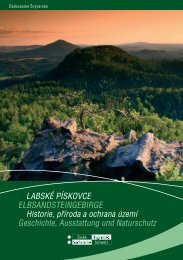ABSTRACT BOOK Sandstone Landscapes ... - Sandstones.org
ABSTRACT BOOK Sandstone Landscapes ... - Sandstones.org
ABSTRACT BOOK Sandstone Landscapes ... - Sandstones.org
Create successful ePaper yourself
Turn your PDF publications into a flip-book with our unique Google optimized e-Paper software.
TFrank MüllerTechnische Universität Dresden, Institut für Botanik, Mommsenstr. 13, D-01062 Dresden, Deutschland(fmueller@rcs.urz.tu-dresden.de)Distribution patterns and conservation status of endangered bryophytes in Saxonian SwitzerlandThe Saxonian Switzerland is an area very rich in bryophytes. 457 bryophyte species have been reported inthe area. 389 species occur here at present.The species richness is especially high in narrow sandstone ravines because of it’s special climaticconditions (high humidity; reducing and delaying effect on temperature fluctuations: during cold fronts, thebottoms of the ravines are warmer than the plateaus and reefs, during warm fronts, they are colder than theplateaus and reefs).For the distribution of bryophytes in the ravines, the climate, among other factors (e.g. soil, relief,competition, humidity), is of great importance. In the ravines, the share of boreo-montane, coldness andhumidity loving species is much higher than on the plateaus. Dryness resistent species are more commonon the plateaus.Remarkable montane, boreal, subalpine und subarctic elements of the bryophyte flora of the SaxonianSwitzerland are e.g. Anastrophyllum michauxii, Cephalozia leucantha, Dicranodontium asperulum,Fissidens osmundoides, Hygrobiella laxifolia, Mylia taylorii.Remarkable atlantic elements are e.g. Campylopus fragilis und Porella pinnata (extinct).There are 200 endangered species (species of the red lists of Saxony or Germany) among the bryophytesdiscovered in the area, of which 137 species have been found recently. The percentage of rare andendangered species is much higher for bryophytes than for phanerogams.Especially remarkable endangered species of the area are the following species critically endangered inSaxony: Anastrophyllum michauxii, Drepanocladus cossonii, Fissidens osmundoides, Fissidens rufulus,Frullania dilatata, Geocalyx graveolens, Hookeria lucens, Leiocolea alpestris, Leucodon sciuroides,Neckera crispa, Riccardia latifrons, Scapania cuspiduligera, Sphagnum contortum, Sphagnum warnstorfii.Important substrates for endangered bryophytes in the Saxonion Switzerland are acidophytic sandstonerocks and boulders, calcareous sandstone rocks, oligotrophic and base-rich swamps, sandstone walls,boulders in streams and brooks, the bark of trees, dead wood, the forest floor of coniferous forests, basaltboulders and springs in forests.The nature conservation status of the bryophytes in the national park sector of the Saxonion Switzerland isgood. Otherwise a high percentage of endangered species is also found in the landscape reserve area. Here,five species of the highest red list category (critically endangered) occur which are not present in thenational park sector. For the protection of these endangered species, stronger conservation measurementsare necessary.TMartin NerudaFaculty of Environmental Studies, University of J. E. Purkyně, Králova výšina 7, Ústí nad Labem, CZ-40096, Czech Republic (neruda@fzp.ujep.cz; tel: +420 47 530 97 39; fax: +420 47 530 97 58)Quantitative hydrological model of the Ploučnice catchment using neural networksAn application deals with calibration of neural model and Fourier series model for Ploučnice catchment.This approach has an advantage, that network choice is not dependent on other example’s parameters. Eachnetworks, and their variants (different units and hidden layers number) can be connected in as a “blackbox” and tested independently. A Stuttgart neural simulator SNNS is used for testing. A perceptronnetwork has been constructed, which was trained by back propagation method improved with a momentumterm. The network is capable of an accurate forecast of next day runoff on the base of runoff and rainfallvalues from previous data.




